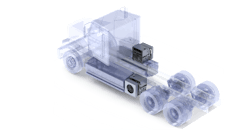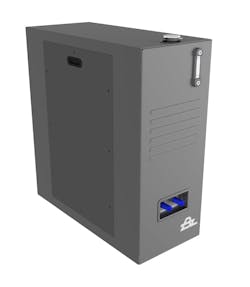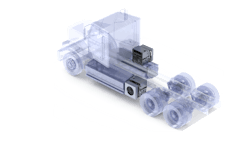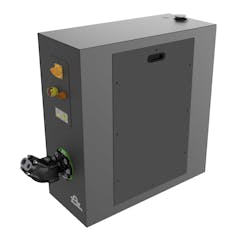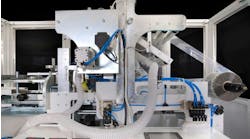ePTOs Enable Continued Use of Hydraulics in Electric Vehicles
Power take-offs (PTO) are an important component on many vocational vehicles, such as dump trucks, as they help drive various systems including hydraulics. Like many other industries, there is a push to electrify these vehicles which is increasing development of ePTOs (electric power take-offs) to power the hydraulics that will still be used on many electric vehicles.
The PTO is used to transmit power for the operation of auxiliary functions of a hydraulic circuit or system which has traditionally come from the engine and transmission, said Brad Gulick, Aftermarket Commercial Product Manager at Eaton.
But with the engine now being replaced by a battery-electric powertrain, a PTO capable of harnessing the electric power supplied by the batteries is required – hence the rise in companies developing ePTOs.
Considerations for the Design and Integration of ePTOs
There are several aspects which need to be taken into consideration when integrating an ePTO. Gulick said a key one is understanding the parameters of the hydraulic system.
If the application is a bucket truck, only so many gallons per minute (gpm) will be required for its operation whereas a crane truck will require more flow, so it is important to properly size the PTO to the truck and its operational needs he said.
Other aspects which need to be considered include the operating voltage utilized on the vehicle. Gulick said when Eaton first entered this market, voltages were in the range of 680-720V and now they are around 800V. “We’re seeing a big shift [in voltages] and the reason they’re going up is they’re looking at bigger hydraulic systems,” he said.
He explained that the hydraulic pumps on many of these trucks are getting bigger to add more functions. Instead of one or two hydraulic circuits there are now four or five to drive a crane, air compressors, outriggers or other accessories. “I think [OEMs] are getting more comfortable with the room on these vehicles and they can add more,” he said. “They can get the weight down on the vehicle and add more functions…run with hydraulics.”
Understanding how the ePTO will interface with other electronics and systems on a vehicle is important as well, requiring close collaboration between the ePTO manufacturer and vehicle OEM said Ghajari. “Since we are going to draw power…going to drain the batteries, they [OEMs] want to know more,” he said. “They want to understand how much current we’re taking [and] how long we’re going to use it.
“They want to know exactly how we are going to operate, and we need to know exactly what they're providing us to not go above their limitations,” he added.
Related to this is the connectors and cabling that will be utilized. Parker Chelsea said while it may seem these components are simple to source off the shelf, there are many options available today and it is important to be intentional about the ePTO design as well as what it is plugging into.
OEM Collaboration Key to Success
Ghajari said ePTO systems are more complicated and contain more parts than a traditional power take-off, so there is more integration and OEM involvement required. The additional parts in an ePTO system also means there is more space required, necessitating collaboration to ensure proper packaging on the vehicle.
He said ProDrive is working to simplify ePTO designs but there are some technological restrictions. For instance, electric motors and inverters above 20 kW require a separate cooling system. Here again it will be necessary to collaborate with OEMs to determine how to address this additional cooling need.
There are some approaches in the market under development; in Europe, some OEMs are increasing their cooling power 10 kW which then provides enough cooling for the ePTO as well. Another possible consideration is for PTO manufacturers to package the motor, inverter and cooling into a single standalone unit, but again Ghajari said there are technology restrictions associated with this approach such as cooling the inverter. Electric motors have reached a point in which they can be oil cooled but it is not currently possible to reach good efficiency levels with just oil cooling an inverter, he said.
Gulick noted that ePTO technology is so new and changing so rapidly that sometimes Eaton must make changes midway through the development process. In one example he shared, the company had an ePTO design ready to go that would be packaged right behind the cab of the truck but then the customer said it needed to bump out its frame rail, requiring a complete change to the packaging.
Because of the increased complexity associated with ePTO systems and the varying requirements of vehicle manufacturers, Ghajari said most ePTOs are developed on a case-by-case basis. The lack of standard interfaces used throughout the industry necessitates this as well. He said everyone is doing things differently which has made it difficult for PTO manufacturers to offer plug-and-play solutions.
Differing interfaces between vehicle manufacturers means companies like ProDrive must adjust software and sometimes hardware as well which not only increases complexity but costs as well. SAE is working on a standard to have more conformity for the interface connections used in electric vehicles but those are still under development. Once those are put in place though, it will be easier for PTO manufacturers to create plug-and-play solutions and ease the integration process for all parties.
ePTOs can Benefit Electric- and Diesel-Powered Vehicles
Development of ePTOs is on the rise due to the growth of electric vehicles and the necessity of these systems for powering their auxiliary equipment and hydraulics. But they can also be used in conventional internal combustion engine-powered vehicles.
Use of ePTOs on a traditional vehicle can eliminate the need for idling, helping to reduce noise, emissions and fuel use. This can benefit a vehicle’s use in confined spaces or noise-sensitive areas while also reducing operational costs for vehicle owners.
Ghajari explained that when used in an engine-powered vehicle, the ePTO has its own battery system which is charged by the engine or the grid. He said this setup is much more efficient than using a transmission-based PTO as you would need to keep a 300-400 hp engine running to supply the 10 hp demanded by a traditional PTO which is extremely inefficient.
He noted utility trucks are an application in which the use of an ePTO is becoming popular for both electric- and diesel-powered vehicles. For diesel options, it is typically a standalone package consisting of a battery, onboard charger and a hydraulic pump. On these trucks the ePTO is used to move the bucket which Ghajari said does not require much power to operate. Noise, emissions and cost savings can all be achieved by using the ePTO to operate the bucket instead of the engine.
READ MORE: Hydraulic System Runs with Engine Shut Off
The energy and cost savings benefit associated with using an ePTO in engine-powered vehicles is driving growth for these systems, said Ghajari.
ePTOs used in electric vehicles offer several advantages as well. In terms of energy management, he said electric motor does not have to run all the time which helps to improve efficiency. The electric motor’s ability to instantly speed up enables immediate use of the hydraulic system, enabling operators to remain productive.
In addition, it will no longer be necessary to have several variations of speed ratios because desired speeds can be set electronically. This will aid OEMs in developing different variants of their trucks as they will be able to use the same PTO and just modify the electric motor software as needed.
Going forward, Gulick and Girardi see ePTO demand continuing to grow for both retrofit and new build applications. The retrofit options will help those who want a more immediate solution to aid their emissions reduction efforts.
In addition, those who choose to retrofit will have the opportunity to become more comfortable with hybrid and electric vehicle technology and assess if it is the right solution for their application.
READ MORE: Revenue Potential Increasing for Electric Truck Powertrain Components
